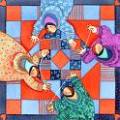
Quilting Reviews
|
Making Sense OF Quilt Patterns
Making Sense OF Quilt Patterns
There are literally thousands of quilt patterns already in existence, and more being designed everyday. If you are a beginning quilter it is best to stick to the simpler patterns. As you become more experienced, you will never run out of new patterns to try.
Some examples of simple patterns use squares. A Four Patch uses four squares of fabric sewn together to make one block. A Nine Patch uses nine small squares to make up one block. Different prints and colors can be mixed and matched to create different looks with these basic blocks. A Double Nine Patch is made up of nine 4-inch squares. The middle square is divided into nine 1 1/3 inch squares. Traditionally the large squares are cut from 4 dark and 4 light fabrics, while the small squares are cut from 4 light and 5 medium colored fabrics. Color combination may be varied to create different patterns.
The Churn Dash is another easy pattern. This block uses 3 different fabrics-2 designs and one background fabric. Variations of this pattern include the Grecian Design, the Greek Cross and the Wrench. There are three major pattern pieces: a 4 inch square, a 2x4 inch rectangle and a large triangle.
The Log Cabin design is probably the most well recognized quilt pattern. It is made of strips of fabric sewn together to give the appetence of a log structure.
The names of quilt patterns often reflect certain aspects of life. Names such as Job's Tears, Bethlehem Star, Cross and Crown, Jacobs Ladder reflect the Spiritual aspect.
Love and marriage is reflected in patterns like Hopes and Wishes, Lover's Knot, Double Wedding Ring and Cupid's Own.
Every state has at least one pattern named after it. These include Ohio Star, California Rose and Carolina Lily.
Not all quilt patterns are suitable for beginners. Drunkard's Path is definitely one. Once you have mastered it, it may quickly become a favorite.
Choosing fabric goes hand in hand with choosing a pattern. In fact there is great debate in quilting circles over which should be chosen first. While once quilts were made from scraps and leftovers, quilter's today have a wide variety of resources to choose from, and may purchase fabric expressly to create a quilt from it. One thing to remember is that it is better to buy to much fabric then to not have enough. Colors can't always be matched from different sources and runs.
Color is probably the most important aspect of any quilt. It is important to study tones, shades and hues. The easiest color scheme for a beginning quilter is probably monochromatic. This means one color, but different shades. Value is the lightness or darkness of a hue. A range of values provides contrast and depth to a pattern. A dominant color should be found in almost all of the quilt's blocks. An accent color should be used to create contrast and a blender color contains both colors in a pattern. When in doubt try a sample block first.
 |
 |
 |
Quilting Is A Hot D.I.Y. Craft
Sewing Tips For Beginning Quilters
Where To Find Free Quilt Patterns
More Quilting Articles
Essential Supplies For Quilting
... quilters have very specific preferences for-you might prefer good old fashioned straight pins made of all steel, or T-pins, or pins with the brightly colored heads. Why not put a variety on your shopping list of supplies and experiment with which ones you like best? You'll also need needles and a seam ...
Sewing Tips For Beginning Quilters
... eye. The appliqu stitch should leave a small visible dot of a stitch. To begin, start with a quilting needle and knotted quilting thread in a color that blends with the appliqu motif. Prepare the design by basting the raw edges under. Pressing with the tip of an iron first will help. Next baste the fabric ...
... are nearly overwhelmed with all the choices in fiber and color. Bolts of fabrics in a rainbow of colors assail the senses. The contemporary quilter is lucky indeed to have the huge array of fabrics available to her. However, this embarrassment of riches can also lead to uncertainty in selecting the correct ...
Add Life To Your Quilting With Embroidery
... perle cotton, rayon, silk and even linen and hemp. They also feature brilliant colors, with some even offering hand-dyed and variegated flosses. Many quilters prefer to do their quilting by machine, instead of hand, and these same quilters may also prefer to do their embroidery by machine. With the huge ...

|
| Copyright © 2006-2012 Internet Marketing Tools, All Rights Reserved |